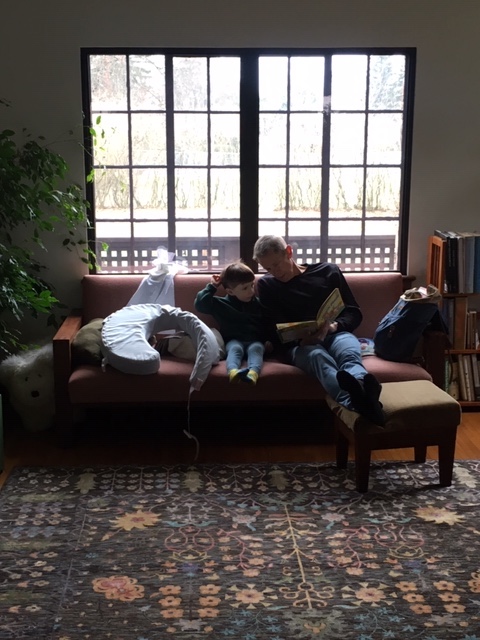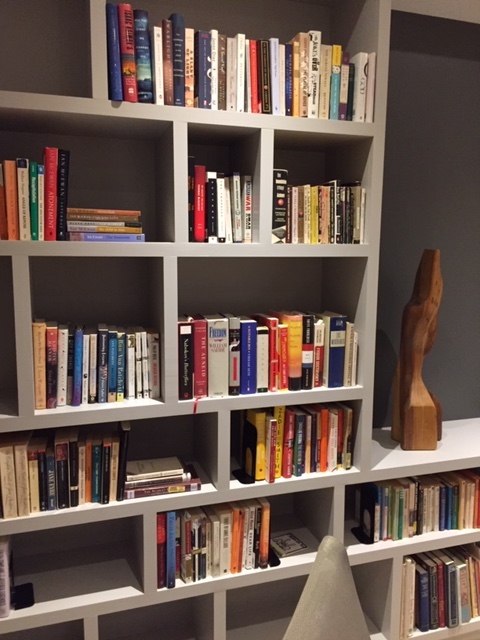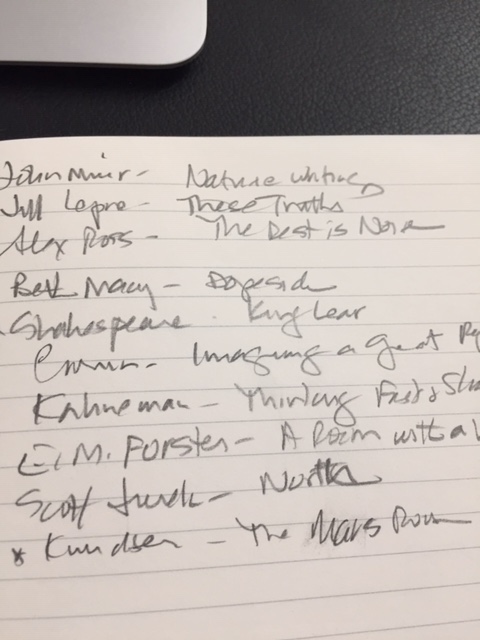Starting young: Solomon reading with Grandpa Doug
Eclectic best describes the spectrum of books I read this year. Some choices were intentional, others were spur-of-the-moment, ten or so were book club picks, still others were recommendations from friends, “best of” lists (a variety of sources, including The Guardian, Bill Gates, and The New York Times), new publications from long-time favorite authors, re-readings of especially meaningful books from different periods of my life, book award winners or long-or-short-listed for various honors, and a focus on United States history (which is continuing into 2019).
Once again, my list included a slight slant to works of fiction but non-fiction played a strong role, with particular focus on geographical diversity. I read several books about Peru and South America in preparation for our almost-two-week hiking trip to Cuzco, the Sacred Valley and Machu Picchu: “Lost City of the Incas,” by Hiram Bingham (his epic book on the discovery of Machu Picchu), “Bel Canto,” by Ann Patchett (the somewhat mystical story of civil strife in an unknown South American country with unexpected love and music interwoven into the harrowing hostage taking), and “Death in the Andes,” by Mario Llosa Vargas (a novel based on the Shining Path terrorism in Peru in 1980s).
My younger son spent nine weeks in Rwanda this summer, so books about Africa were important: “The Shadow of the Sun,” by Ryszard Kapusckinski (notes from a long-time journalist in Africa), “A Thousand Hills to Heaven, Love, Hope and a Restaurant in Rwanda,” by Josh Ruxin (the founding of Heaven Restaurant in Kigala as social enterprise), and “The Girl Who Smiled Beads, a Story of War and What Comes After,” by Clemantine Waramiya (a memoir of a survivor of the 1994 Rwanda genocide followed by seven years in refugee camps in Africa before coming to America).
Pakistan, India, and refugees were the subjects of several heart-breaking books: “Discontent and its Civilizations,” by Mohsin Hamid (essays from this journalist), “Exit West,” also by Mohsin Hamid (the fictional account of immigrants traveling to places unknown to escape the wars and devastation of their home countries), “Behind the Beautiful Forevers: Life, Death and Hope in a Mumbai Undercity, “by Katherine Boo (a true account of families living in the slums near Mumbai International Airport), and “The Art of Writing,” by Edwidge Danticat (author explores death and how people die, primarily by reviewing writers by others on death experiences, her family’s rituals in Haiti, and the concept of “dying livingly”).
Other books with international settings included “The Piano Shop on the Left Bank, Discovering a Forgotten Passion in a Paris Atelier,” by Thad Carhart (a delightful account of a writer relocating to Paris and rediscovering his love of the piano after stumbling upon a small, out-of-the-way piano shop on a Parisian alley), “Flights,” by Olga Torakczuk (winner of the Man Booker International Prize, this book explores travel, movement, mobility, time and space through short anecdotes, continuing characters, musings, and the rootlessness of the narrative/author), “Northland, a 4,000-mile Journey along America’s Forgotten Border,” by Porter Fox (a journey by canoe, car, trains and on foot along the Canadian/American border within historical and natural context), and “Swimming Lessons,” by Claire Fuller (again, the concept of family, secrets, disappointments in life).
A number of books were set in World War II or post-WWII Europe/Russia, including“An Artist of the Floating World,” by Kazuo Ishiguro (post-WWII Japan, an artist looks back on his pro-Imperialist paintings and tries to reconcile his life to those lost values), “Pereira Maintains,” by Antonio Tabucchi (another post-WWII book based in Portugal, where a writer gets caught up in the revolutionary cause), “City of Thieves,” by David Benioff (unlikely encounters and friendships during siege of Leningrad), “Warlight,” Michael Ondaatje (one of my favorite English authors, again set in WWII, two young children left by parents, supposedly cared for by strangers, with the underlying story of intrigue, spies, and the concept of family), and “Paris Echo,” by Sebastian Faulks (two individuals unlikely connection in modern-day Paris, discovering images and links to Paris of WWII). I re-read the British classic, “The Remains of the Day,” also by Kazuo Ishiguro (what is loyalty? Do we change from experience or in learning that what we thought was important was in fact false?)
US-focused books with historical focus were also part of my year of reading: “Imagining a Great Republic,” by Thomas Cronin (he undertakes review of American literary and social culture classics to delve into and try to understand the multi-faceted “American narrative”), “Killers of the Flower Moon,” David Grann (historical look at the Osage tribe murders in Oklahoma and early years of the FBI), “Full Body Burden, Growing up in the Nuclear Shadow of Rocky Flats,” by Kristen Iversen (memoir of living near Front Range Rockies nuclear-power plant and mis-information, lying, and misrepresentation of the health effects), “The Edge, the War against Cheating and Corruption in the Cutthroat World of Elite Sports,” by Roger Pielke, Jr. (conflict between the “performance edge” and “ethical edge” in sport, with historical up to present-day issues of doping, performance-enhancing, “clean sport”), “These Truths, a History of the United States,” by Jill Lepore (extensive history of US from perspective (not dissimilar to Imagining a Great America) of “these truths we hold to be self-evident,” i.e., an objective, evidence-based history compared to the “myth” of the US), “Educated,” by Tara Westover (memoir of girl whose family lived off-the-grid in Idaho, living home, trying to reconcile love and family at potential cost of loss of self-esteem), “My Stroke of Insight, a Brain Scientist’s Personal Journey,” by Jill Bolte Taylor (author narrates her traumatic brain injury and eight years of recovery, teaching her left and right sides of the brain to be fully functional), and “Shoe Dog: A Memoir by the Creator of Nike,” by Phil Knight.
This list also included the classics “American Pastoral,” by Philip Roth, “Angle of Repose,” by Wallace Stegner (probably my favorite twentieth century American author with his focus on place), and “The House of Mirth,” by Edith Wharton.
A sprinkling of books by black women (whose writings I find exceptionally emotional, precise, and heart-breaking) included “Americanah,” by Chimamande Ngozi Adichie (what does it mean to be “black” in America), “Stay with Me, a Novel,” by Ayobami Adebayo (explores the nature of family relationships in Nigeria, devastation of sickle-cell anemia), “Sing, Unburied, Sing,” by Jesmyn Ward (mystical realism about poor black family in Mississippi, family ties and ghosts), and “An American Marriage, a Novel,” by Tayari Jones (what it means to be a black man in America, what is family, relationships that bind).
Several recent books about families in rural mid-states and South touch upon the tragedies of times in our history (and imagined future), included “Before We Were Yours,” by Lisa Wingate (true account of young children who were victims of Georgia Tann and Memphis Children’s Home Society, taking poor children from their families and selling them to rich ones), “Anything is Possible,” by Elizabeth Stout (short stories centered around families in rural Illinois, poverty, betrayal, success and failure), and “American War,” by Omar El Akkad (imagining of second Civil War, post-apocalyptic US).
Some other books with family as a central theme, included “Every Note Played,” by Lisa Genova (the devastating effects of ALS on family but again, ties that bind even though choices made would have made different outcome), “Run,” by Ann Patchett (racial/economic/social differences between two families, one black, one white), “Unsheltered” by Barbara Kingsolver (using narrative of two families living in the same house, but centuries apart, tries to tie together financial and social crises that cause one to become “unsheltered,” without moorings both physical and emotional), “The Sisters Brothers,” by Patrick deWitt (set in 1850s gold rush era of California, the adventures of two assassin-brothers as they carry out their jobs in the hard and rough scrabble of Wild West), and “The Mars Room,” by Rachel Kushner (Romy Hall is serving two-consecutive life sentences in women’s prison in California’s Central Valley; the story toggles between her life before prison, with its hardships, and her life in prison with the harsh realities of that environment).
Books in the miscellaneous category included “The Power of Impact Investing,” by Judith Rodin and Margot Brandenburg (guide to impact investing, where seek both financial gain and social/environmental impact), “Bad Blood, Secrets and Lies in a Silicon Valley Start-up,” by John Carreyrou (incredible rise and fall of $10billion-value Theranos and its founder and CEO, Elizabeth Holmes), “The Art of Memoir,” by Mary Karr (author of numerous memoirs provides tools of finding one’s voice, engaging with audience, a “how-to” primer on writing memoirs), “Change Agent, a Novel,” by Daniel Suarez (the future world of eugenics), “The Great Alone,” by Kristin Hannah (another off-the-grid family story of domestic violence and love set among harsh Alaskan frontier), and “Enduring Love,” by Ian McEwan (a favorite British author, this story is uses de Clerambault syndrome, where one individual claims to be best friend of an innocent bystander, wreaking havoc with his life).
Starting my list for 2019
What a year it was, traveling in the minds of such talented authors. I’m already jotting down titles for 2019. I am excited to start another journey, likely hundreds of hours of thoughtful, inspirational and informative reading in the year ahead.



Wonderful distillations of the books!
What an impressive list – thanks so much for sharing your literary insights with us. You inspire me in so many ways❤️